tires DODGE DAKOTA 2011 3.G User Guide
[x] Cancel search | Manufacturer: DODGE, Model Year: 2011, Model line: DAKOTA, Model: DODGE DAKOTA 2011 3.GPages: 76, PDF Size: 4.62 MB
Page 39 of 76
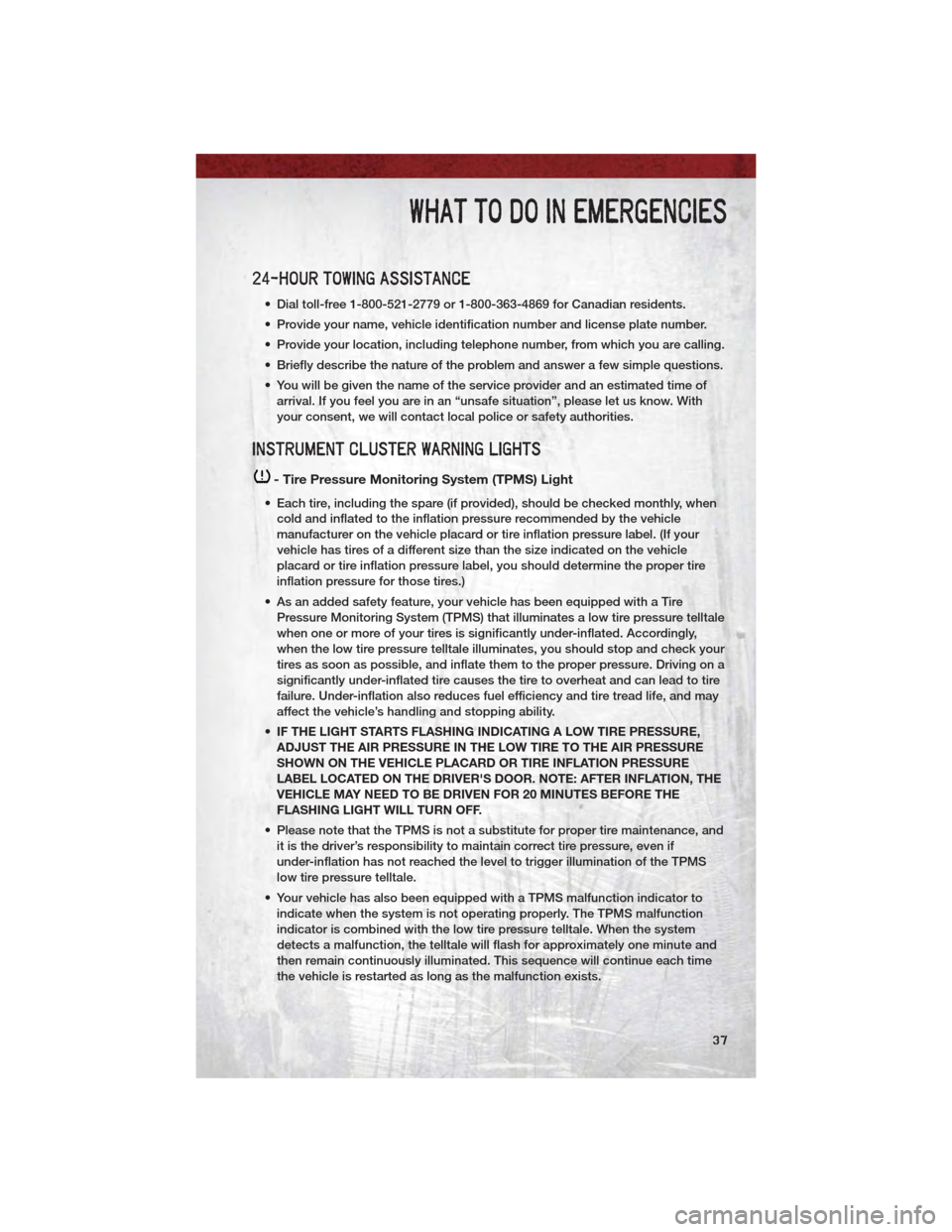
24-HOUR TOWING ASSISTANCE
• Dial toll-free 1-800-521-2779 or 1-800-363-4869 for Canadian residents.
• Provide your name, vehicle identification number and license plate number.
• Provide your location, including telephone number, from which you are calling.
• Briefly describe the nature of the problem and answer a few simple questions.
• You will be given the name of the service provider and an estimated time ofarrival. If you feel you are in an “unsafe situation”, please let us know. With
your consent, we will contact local police or safety authorities.
INSTRUMENT CLUSTER WARNING LIGHTS
- Tire Pressure Monitoring System (TPMS) Light
• Each tire, including the spare (if provided), should be checked monthly, whencold and inflated to the inflation pressure recommended by the vehicle
manufacturer on the vehicle placard or tire inflation pressure label. (If your
vehicle has tires of a different size than the size indicated on the vehicle
placard or tire inflation pressure label, you should determine the proper tire
inflation pressure for those tires.)
• As an added safety feature, your vehicle has been equipped with a Tire Pressure Monitoring System (TPMS) that illuminates a low tire pressure telltale
when one or more of your tires is significantly under-inflated. Accordingly,
when the low tire pressure telltale illuminates, you should stop and check your
tires as soon as possible, and inflate them to the proper pressure. Driving on a
significantly under-inflated tire causes the tire to overheat and can lead to tire
failure. Under-inflation also reduces fuel efficiency and tire tread life, and may
affect the vehicle’s handling and stopping ability.
• IF THE LIGHT STARTS FLASHING INDICATING A LOW TIRE PRESSURE,
ADJUST THE AIR PRESSURE IN THE LOW TIRE TO THE AIR PRESSURE
SHOWN ON THE VEHICLE PLACARD OR TIRE INFLATION PRESSURE
LABEL LOCATED ON THE DRIVER'S DOOR. NOTE: AFTER INFLATION, THE
VEHICLE MAY NEED TO BE DRIVEN FOR 20 MINUTES BEFORE THE
FLASHING LIGHT WILL TURN OFF.
• Please note that the TPMS is not a substitute for proper tire maintenance, and it is the driver’s responsibility to maintain correct tire pressure, even if
under-inflation has not reached the level to trigger illumination of the TPMS
low tire pressure telltale.
• Your vehicle has also been equipped with a TPMS malfunction indicator to indicate when the system is not operating properly. The TPMS malfunction
indicator is combined with the low tire pressure telltale. When the system
detects a malfunction, the telltale will flash for approximately one minute and
then remain continuously illuminated. This sequence will continue each time
the vehicle is restarted as long as the malfunction exists.
WHAT TO DO IN EMERGENCIES
37
Page 40 of 76
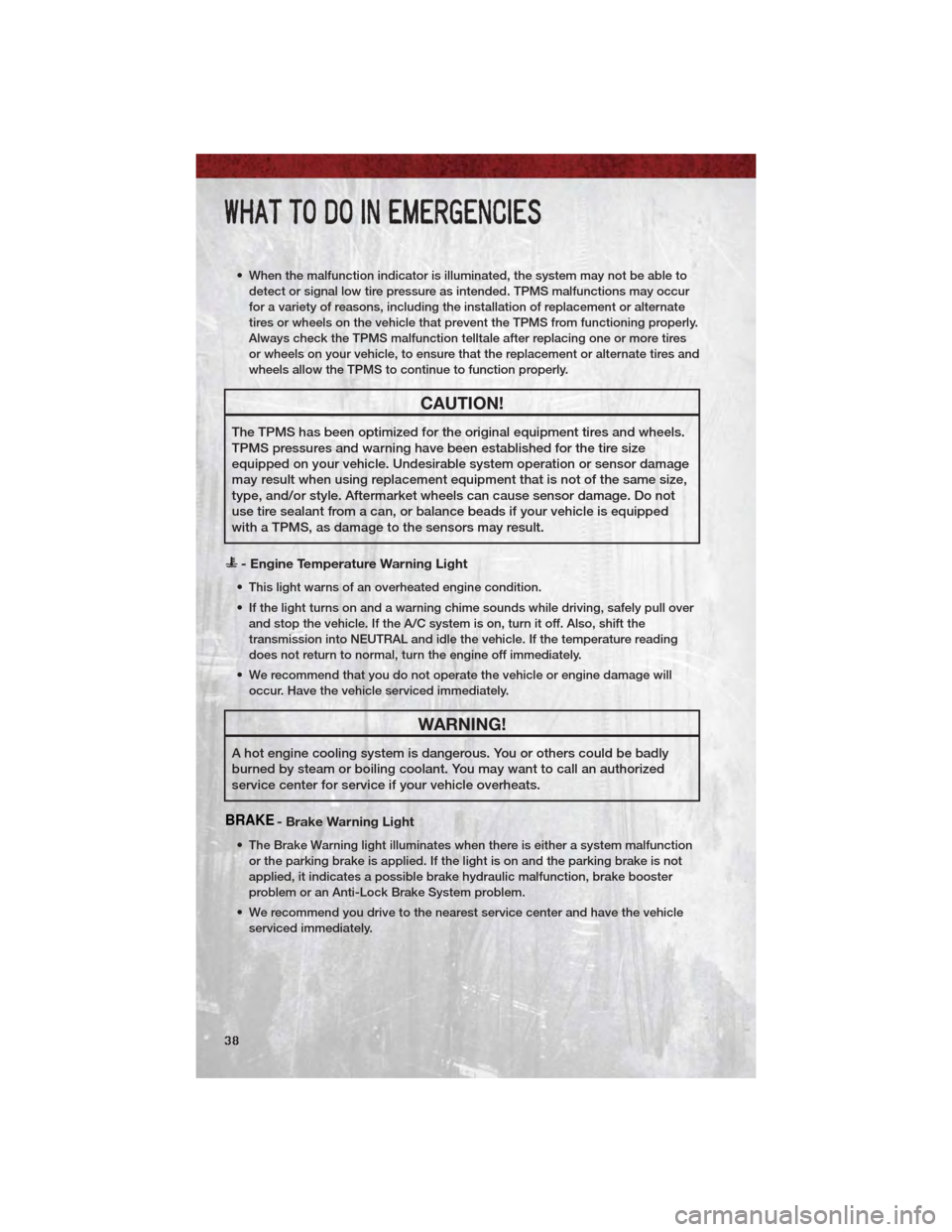
• When the malfunction indicator is illuminated, the system may not be able todetect or signal low tire pressure as intended. TPMS malfunctions may occur
for a variety of reasons, including the installation of replacement or alternate
tires or wheels on the vehicle that prevent the TPMS from functioning properly.
Always check the TPMS malfunction telltale after replacing one or more tires
or wheels on your vehicle, to ensure that the replacement or alternate tires and
wheels allow the TPMS to continue to function properly.
CAUTION!
The TPMS has been optimized for the original equipment tires and wheels.
TPMS pressures and warning have been established for the tire size
equipped on your vehicle. Undesirable system operation or sensor damage
may result when using replacement equipment that is not of the same size,
type, and/or style. Aftermarket wheels can cause sensor damage. Do not
use tire sealant from a can, or balance beads if your vehicle is equipped
with a TPMS, as damage to the sensors may result.
- Engine Temperature Warning Light
• This light warns of an overheated engine condition.
• If the light turns on and a warning chime sounds while driving, safely pull overand stop the vehicle. If the A/C system is on, turn it off. Also, shift the
transmission into NEUTRAL and idle the vehicle. If the temperature reading
does not return to normal, turn the engine off immediately.
• We recommend that you do not operate the vehicle or engine damage will occur. Have the vehicle serviced immediately.
WARNING!
A hot engine cooling system is dangerous. You or others could be badly
burned by steam or boiling coolant. You may want to call an authorized
service center for service if your vehicle overheats.
BRAKE- Brake Warning Light
• The Brake Warning light illuminates when there is either a system malfunctionor the parking brake is applied. If the light is on and the parking brake is not
applied, it indicates a possible brake hydraulic malfunction, brake booster
problem or an Anti-Lock Brake System problem.
• We recommend you drive to the nearest service center and have the vehicle serviced immediately.
WHAT TO DO IN EMERGENCIES
38
Page 48 of 76
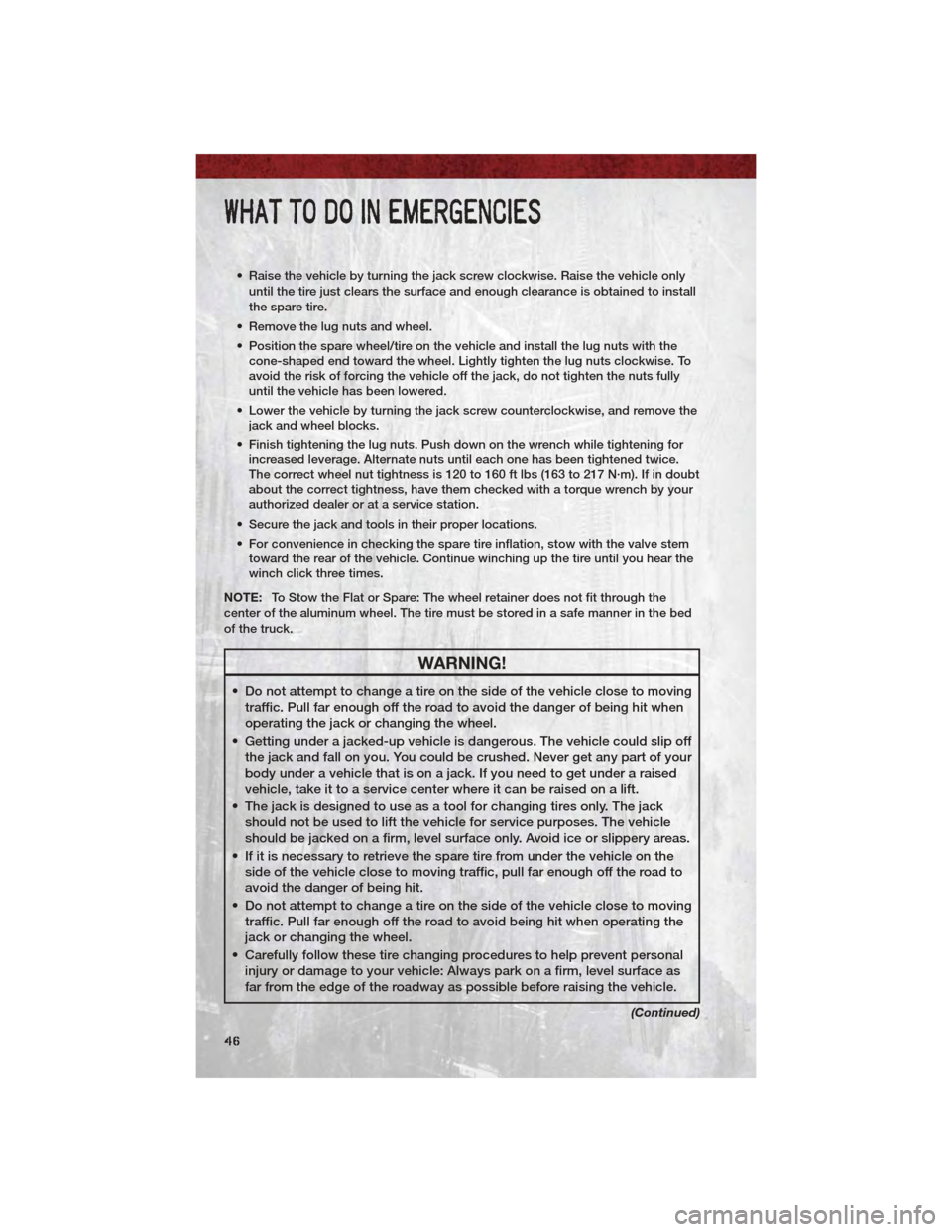
• Raise the vehicle by turning the jack screw clockwise. Raise the vehicle onlyuntil the tire just clears the surface and enough clearance is obtained to install
the spare tire.
• Remove the lug nuts and wheel.
• Position the spare wheel/tire on the vehicle and install the lug nuts with the cone-shaped end toward the wheel. Lightly tighten the lug nuts clockwise. To
avoid the risk of forcing the vehicle off the jack, do not tighten the nuts fully
until the vehicle has been lowered.
• Lower the vehicle by turning the jack screw counterclockwise, and remove the jack and wheel blocks.
• Finish tightening the lug nuts. Push down on the wrench while tightening for increased leverage. Alternate nuts until each one has been tightened twice.
The correct wheel nut tightness is 120 to 160 ft lbs (163 to 217 N·m). If in doubt
about the correct tightness, have them checked with a torque wrench by your
authorized dealer or at a service station.
• Secure the jack and tools in their proper locations.
• For convenience in checking the spare tire inflation, stow with the valve stem toward the rear of the vehicle. Continue winching up the tire until you hear the
winch click three times.
NOTE: To Stow the Flat or Spare: The wheel retainer does not fit through the
center of the aluminum wheel. The tire must be stored in a safe manner in the bed
of the truck.
WARNING!
• Do not attempt to change a tire on the side of the vehicle close to moving traffic. Pull far enough off the road to avoid the danger of being hit when
operating the jack or changing the wheel.
• Getting under a jacked-up vehicle is dangerous. The vehicle could slip off the jack and fall on you. You could be crushed. Never get any part of your
body under a vehicle that is on a jack. If you need to get under a raised
vehicle, take it to a service center where it can be raised on a lift.
• The jack is designed to use as a tool for changing tires only. The jack should not be used to lift the vehicle for service purposes. The vehicle
should be jacked on a firm, level surface only. Avoid ice or slippery areas.
• If it is necessary to retrieve the spare tire from under the vehicle on the side of the vehicle close to moving traffic, pull far enough off the road to
avoid the danger of being hit.
• Do not attempt to change a tire on the side of the vehicle close to moving traffic. Pull far enough off the road to avoid being hit when operating the
jack or changing the wheel.
• Carefully follow these tire changing procedures to help prevent personal injury or damage to your vehicle: Always park on a firm, level surface as
far from the edge of the roadway as possible before raising the vehicle.
(Continued)
WHAT TO DO IN EMERGENCIES
46
Page 53 of 76
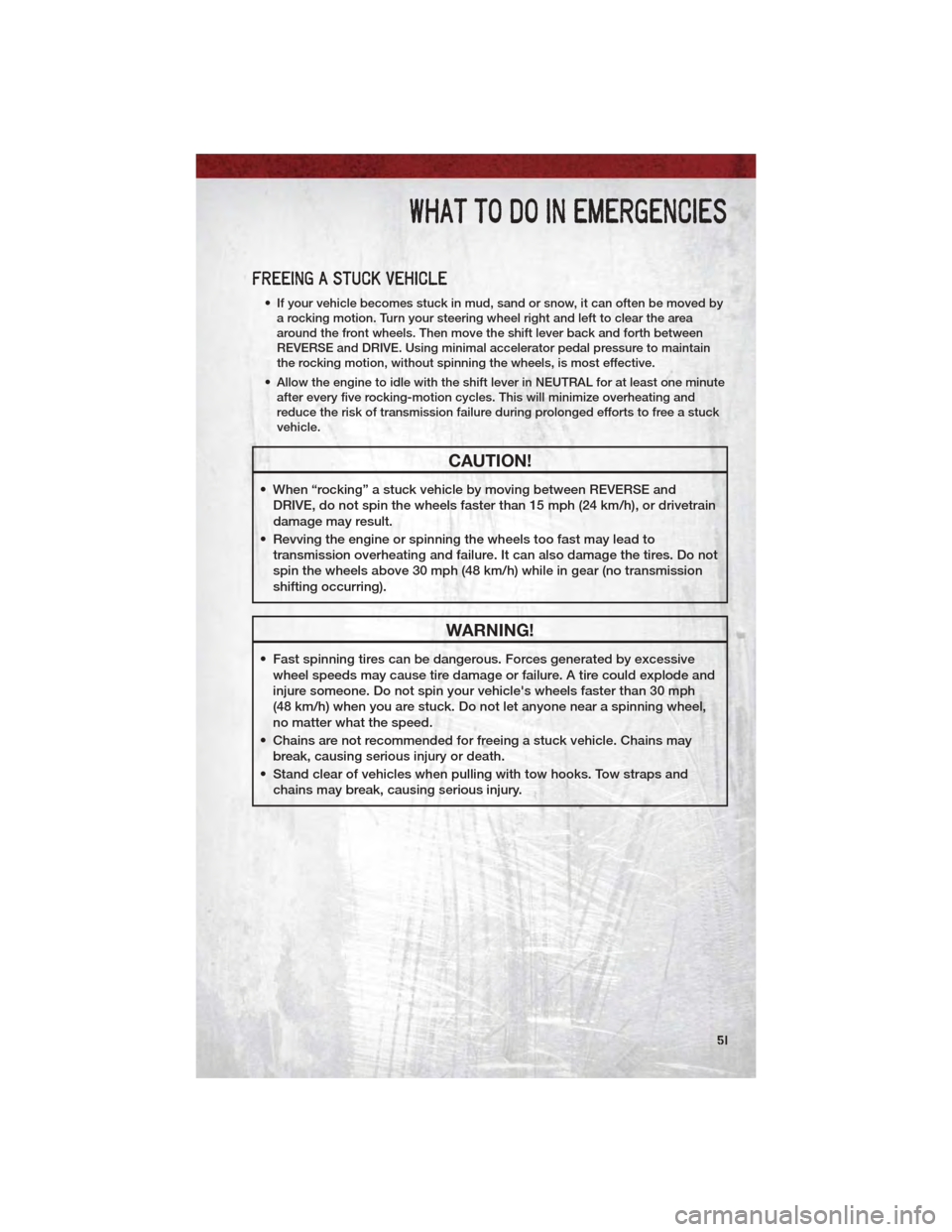
FREEING A STUCK VEHICLE
• If your vehicle becomes stuck in mud, sand or snow, it can often be moved bya rocking motion. Turn your steering wheel right and left to clear the area
around the front wheels. Then move the shift lever back and forth between
REVERSE and DRIVE. Using minimal accelerator pedal pressure to maintain
the rocking motion, without spinning the wheels, is most effective.
• Allow the engine to idle with the shift lever in NEUTRAL for at least one minute after every five rocking-motion cycles. This will minimize overheating and
reduce the risk of transmission failure during prolonged efforts to free a stuck
vehicle.
CAUTION!
• When “rocking” a stuck vehicle by moving between REVERSE andDRIVE, do not spin the wheels faster than 15 mph (24 km/h), or drivetrain
damage may result.
• Revving the engine or spinning the wheels too fast may lead to transmission overheating and failure. It can also damage the tires. Do not
spin the wheels above 30 mph (48 km/h) while in gear (no transmission
shifting occurring).
WARNING!
• Fast spinning tires can be dangerous. Forces generated by excessivewheel speeds may cause tire damage or failure. A tire could explode and
injure someone. Do not spin your vehicle's wheels faster than 30 mph
(48 km/h) when you are stuck. Do not let anyone near a spinning wheel,
no matter what the speed.
• Chains are not recommended for freeing a stuck vehicle. Chains may break, causing serious injury or death.
• Stand clear of vehicles when pulling with tow hooks. Tow straps and chains may break, causing serious injury.
WHAT TO DO IN EMERGENCIES
51
Page 60 of 76

MAINTENANCE CHART
Miles:
8,000 16,000 24,000 32,000 40,000 48,000 56,000 64,000 72,000 80,000 88,000 96,000 104,000
Or Months: 6 12 18 24 30 36 42 48 54 60 66 72 78
Or Kilometers:
13,000 26,000 39,000 52,000 65,000 78,000 91,000 104,000 117,000 130,000 143,000 156,000 169,000
Change the engine oil and filter. XXXXXXXXXXXXX
Rotate the tires, rotate at the first sign of irregular
wear, even if it occurs before scheduled
maintenance. XXXXXXXXXXXXX
If using your vehicle for any of the following: dusty
or off-road conditions. Inspect the engine air
cleaner filter; replace if necessary. XXX
Inspect the brake linings; replace if necessary. X X X X X X
Inspect the CV joints. XXXX
Inspect the exhaust system. Perform the first
inspection at 16,000 miles (26,000 km) or
12 months. XXXXX
Inspect the front suspension, tie rod ends and
boot seals for cracks or leaks and all parts for
damage, wear, improper looseness or end play;
replace if necessary. XXXXXX
Replace the engine air cleaner filter. XXX
Inspect the transfer case fluid. XX
Inspect the front and rear axle fluid if using your
vehicle for any of the following: police, taxi,
off-road or frequent trailer towing. XXXX
Change the automatic transmission fluid & filter(s)
if using your vehicle for any of the following:
police, taxi, fleet, or frequent trailer towing. X
Replace Ignition Cables (3.7L Engine). X
Replace the spark plugs (3.7L engines). XXX
Replace Ignition Cables (4.7L Engine). X
MAINTAINING YOUR VEHICLE
58
Page 66 of 76
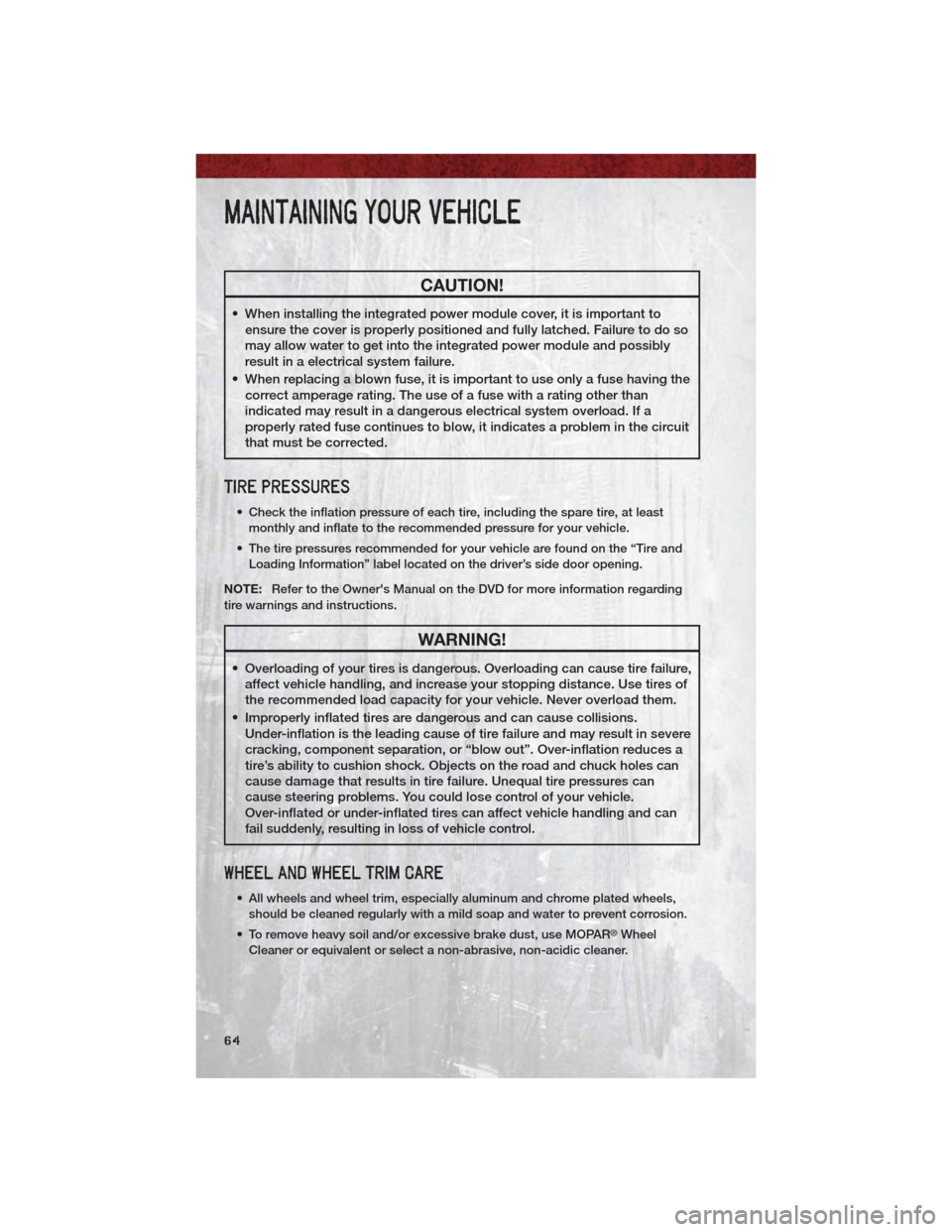
CAUTION!
• When installing the integrated power module cover, it is important toensure the cover is properly positioned and fully latched. Failure to do so
may allow water to get into the integrated power module and possibly
result in a electrical system failure.
• When replacing a blown fuse, it is important to use only a fuse having the correct amperage rating. The use of a fuse with a rating other than
indicated may result in a dangerous electrical system overload. If a
properly rated fuse continues to blow, it indicates a problem in the circuit
that must be corrected.
TIRE PRESSURES
• Check the inflation pressure of each tire, including the spare tire, at least
monthly and inflate to the recommended pressure for your vehicle.
• The tire pressures recommended for your vehicle are found on the “Tire and Loading Information” label located on the driver’s side door opening.
NOTE: Refer to the Owner's Manual on the DVD for more information regarding
tire warnings and instructions.
WARNING!
• Overloading of your tires is dangerous. Overloading can cause tire failure, affect vehicle handling, and increase your stopping distance. Use tires of
the recommended load capacity for your vehicle. Never overload them.
• Improperly inflated tires are dangerous and can cause collisions. Under-inflation is the leading cause of tire failure and may result in severe
cracking, component separation, or “blow out”. Over-inflation reduces a
tire’s ability to cushion shock. Objects on the road and chuck holes can
cause damage that results in tire failure. Unequal tire pressures can
cause steering problems. You could lose control of your vehicle.
Over-inflated or under-inflated tires can affect vehicle handling and can
fail suddenly, resulting in loss of vehicle control.
WHEEL AND WHEEL TRIM CARE
• All wheels and wheel trim, especially aluminum and chrome plated wheels,
should be cleaned regularly with a mild soap and water to prevent corrosion.
• To remove heavy soil and/or excessive brake dust, use MOPAR
®Wheel
Cleaner or equivalent or select a non-abrasive, non-acidic cleaner.
MAINTAINING YOUR VEHICLE
64
Page 72 of 76
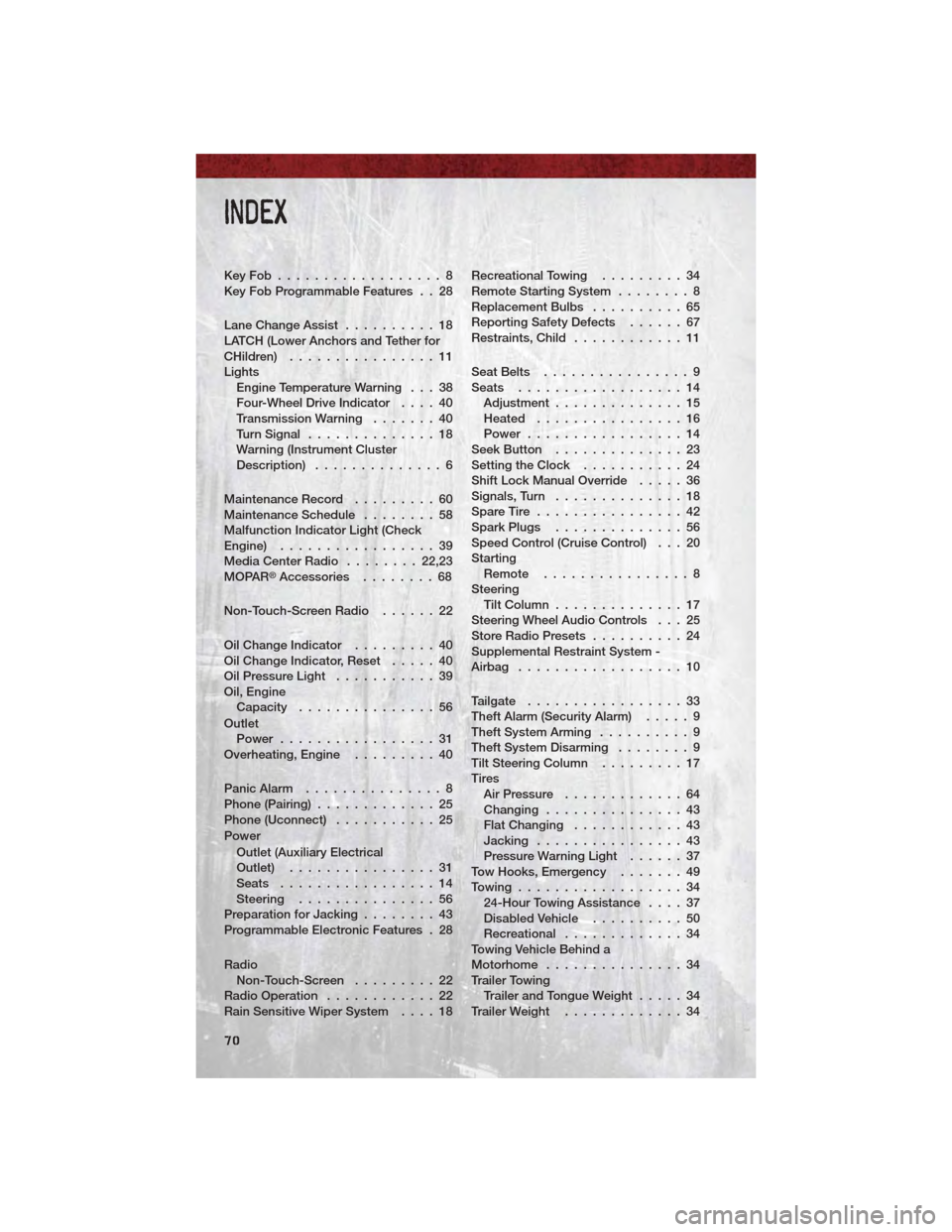
KeyFob..................8
Key Fob Programmable Features . . 28
Lane Change Assist..........18
LATCH (Lower Anchors and Tether for
CHildren) ................11
Lights Engine Temperature Warning . . . 38
Four-Wheel Drive Indicator ....40
Transmission Warning .......40
Turn Signal ..............18
Warning (Instrument Cluster
Description) ..............6
Maintenance Record .........60
Maintenance Schedule ........58
Malfunction Indicator Light (Check
Engine) .................39
Media Center Radio ........22,23
MOPAR
®Accessories ........68
Non-Touch-Screen Radio ......22
Oil Change Indicator .........40
Oil Change Indicator, Reset .....40
Oil Pressure Light ...........39
Oil, Engine Capacity ...............56
Outlet Power .................31
Overheating, Engine .........40
Panic Alarm ...............8
Phone (Pairing) .............25
Phone (Uconnect) ...........25
Power Outlet (Auxiliary Electrical
Outlet) ................31
Seats .................14
Steering ...............56
Preparation for Jacking ........43
Programmable Electronic Features . 28
Radio Non-Touch-Screen .........22
Radio Operation ............22
Rain Sensitive Wiper System ....18Recreational Towing
.........34
Remote Starting System ........8
Replacement Bulbs ..........65
Reporting Safety Defects ......67
Restraints,Child ............11
SeatBelts ................9
Seats ..................14 Adjustment ..............15
Heated ................16
Power .................14
SeekButton ..............23
Setting the Clock ...........24
Shift Lock Manual Override .....36
Signals, Turn ..............18
SpareTire ................42
SparkPlugs ..............56
Speed Control (Cruise Control) . . . 20
Starting Remote ................8
Steering TiltColumn..............17
Steering Wheel Audio Controls . . . 25
Store Radio Presets ..........24
Supplemental Restraint System -
Airbag ..................10
Tailgate .................33
Theft Alarm (Security Alarm) .....9
Theft System Arming ..........9
Theft System Disarming ........9
TiltSteeringColumn .........17
Tires Air Pressure .............64
Changing ...............43
Flat Changing ............43
Jacking ................43
Pressure Warning Light ......37
Tow Hooks, Emergency .......49
Towing..................34 24-Hour Towing Assistance ....37
DisabledVehicle ..........50
Recreational .............34
Towing Vehicle Behind a
Motorhome ...............34
Trailer Towing Trailer and Tongue Weight .....34
TrailerWeight .............34
INDEX
70